Cross Spread
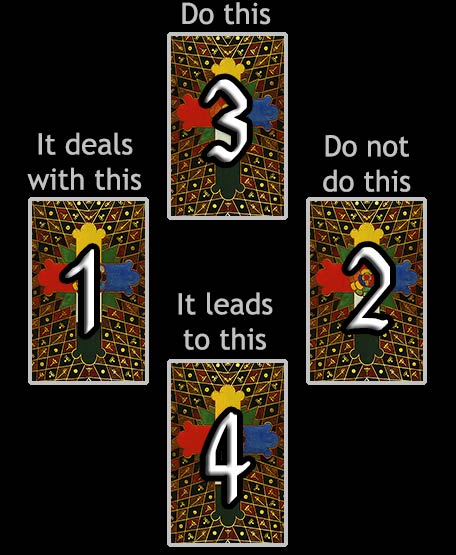
Difficulty: Easy
The Cross Spread is good for questions asking for advice. It can also be used to determine the meaning of a confusing card from a previous reading, or for that matter, to shed light on other points of confusion.
In questions asking advice, this tarot spread is self-explanatory. The main thing is to determine the difference between cards #2 and #3. #1 is the topic and #4 is the result.
In questions regarding confusion, such as: "What was the meaning of Card (X) in the last spread?" the main thing is also to determine the difference between cards #2 and #3. In this case, #2 will show what the card was not referring to, and Card #3 will show what was really meant. Card #1 is the topic and #4 represents the purpose it serves.
Your Cross Reading
DO This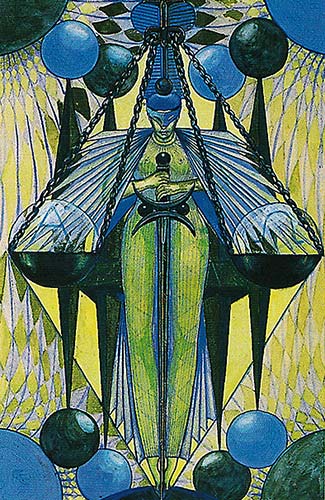 VIII – Adjustment |
||
It Deals with This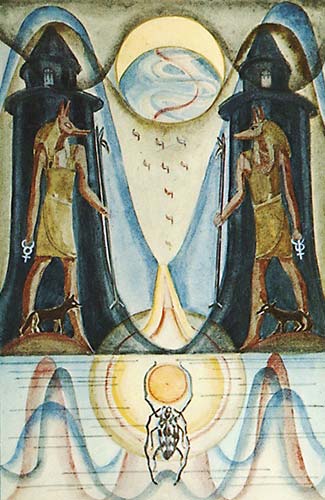 XVIII – The Moon |
Do NOT Do This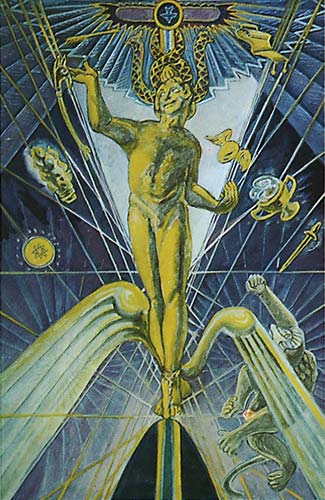 I – The Magus |
|
It Leads to This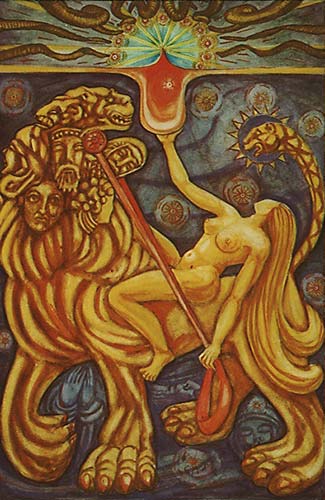 XI – Lust |

It Deals with This
XVIII – The Moon
(Pisces, Qoph)
The Moon symbolises illusion, intuition, and the mysterious depths of the subconscious. Associated with Qoph, the back of the head, this card delves into the primal and instinctual aspects of the psyche. Pisces, the zodiac of dreams and mysticism, enhances the card's themes of mystery and emotional depth.
The imagery is haunting and enigmatic. A path winds through barren terrain, flanked by twin towers that suggest gateways to the unknown. Above, the moon dominates the sky, casting an eerie light that obscures as much as it reveals. Crawling on the path is a scarab beetle carrying the solar disk, symbolising the emergence of light from darkness. The waters below teem with life, representing the fertile chaos of the subconscious.
In Relationships: The Moon represents emotional complexity and hidden dynamics. It encourages you to trust your intuition and uncover underlying truths.
In Work: This card suggests uncertainty or confusion. You are advised to navigate carefully, relying on intuition and patience to discern the best path forward.
Spiritually: The Moon symbolises the journey through the subconscious and the mysteries of the soul. It calls you to explore your inner depths and embrace the wisdom found in dreams and intuition.
When ill-dignified: The Moon warns of deception, confusion, or fear of the unknown. You are advised to confront your fears and seek clarity amidst uncertainty.

Do NOT Do This
I – The Magus
(Mercury, Beth)
The Magus of the Thoth deck radiates dynamic energy, the force of will and intellect that shapes reality. He corresponds to Beth, the house, signifying the power to create structure and form. Governed by Mercury, the Magus represents the mastery of communication, skill, and adaptation, embodying the ability to transmute thought into action.
The Magus stands amidst the elements he commands. Around him swirls the wand, cup, sword, and disk, each imbued with vibrant, electric energy. His figure exudes movement and control, as though he exists in a state of constant creation. Above him, the winged caduceus—the rod of Hermes—rises as a symbol of unity and transformation. The beam connecting heaven and earth signifies the infinite cycle of energy and potential.
In Relationships: The Magus suggests magnetic attraction and the ability to manifest deep, meaningful connections. It emphasises the importance of clear communication and aligning intentions with actions to nurture relationships.
In Work: This card signifies mastery and the ability to manifest success through focus and skill. It advises you to harness your talents and act with precision and intention to achieve your goals.
Spiritually: The Magus represents the awakening of personal power and the alignment of the microcosm and macrocosm. It is a call to take responsibility as a conscious creator in the divine play of existence.
When ill-dignified: The Magus warns of manipulation, overconfidence, or a scattering of energy. You are urged to examine your motives and ensure your actions serve the highest purpose, avoiding the temptation to misuse your gifts.

DO This
VIII – Adjustment
(Libra, Lamed)
In the Thoth deck, the card traditionally known as Justice is renamed Adjustment, reflecting the dynamic nature of balance and the constant recalibration required to maintain harmony. Associated with Lamed, the ox-goad, it represents the guidance and discipline needed to align oneself with universal truth. Libra, the zodiac of balance and fairness, infuses the card with its themes of equity and measured judgement.
The central figure of Adjustment is a serene androgynous figure holding a sword while balancing on their toes, between a balanced pair of scales. The sword symbolises the piercing clarity of truth, while the scales represent the cosmic law of cause and effect. Their poised stance is framed by geometric patterns, emphasising precision and the mathematical order of the universe. Behind them, a brilliant green background evokes the idea of renewal and the living equilibrium of nature.
In Relationships: Adjustment highlights the importance of honesty, fairness, and mutual accountability. It encourages you to communicate openly and seek a balanced dynamic.
In Work: This card suggests success will come through careful analysis, ethical decision-making, and the ability to adapt to changing circumstances. It warns against cutting corners or ignoring the consequences of actions.
Spiritually: Adjustment signifies alignment with divine truth and the quest for inner harmony. You are called to reflect on your actions and ensure they are in alignment with your highest principles.
When ill-dignified: Adjustment warns of imbalance, dishonesty, or an inability to take responsibility for one's actions. You are advised to confront uncomfortable truths and restore equilibrium through introspection and accountability.

It Leads to This
XI – Lust
(Leo, Teth)
Lust, known as Strength in many other decks, takes on a unique and profound meaning in the Book of Thoth. This card signifies the ecstatic embrace of life's passions and the power derived from uniting primal instincts with spiritual purpose. Associated with Teth, the serpent, it symbolises both the kundalini energy and the continuous cycles of transformation and renewal. Leo, the zodiac of courage and vitality, infuses the card with boundless confidence and creative expression.
The central figure is a woman riding a multi-headed beast, a symbol of primal forces mastered and directed towards a higher purpose. Her nudity represents authenticity and fearlessness, while the cup she holds aloft is the Holy Grail, symbolising the ultimate spiritual goal. The beast itself, covered in fiery hues, represents the dynamic power of creation, destruction, and renewal. The background is filled with swirling red and gold, reflecting the intensity of life force and divine energy.
In Relationships: Lust represents passion, desire, and a fearless embrace of emotional intensity. It encourages you to fully engage with your relationships, revelling in love's transformative power.
In Work: This card signifies success achieved through boldness, enthusiasm, and a connection to one's creative instincts. You are advised to channel your energy into projects that ignite your passion.
Spiritually: Lust symbolises the awakening of spiritual vitality and integrating one's primal and divine natures. It calls you to surrender to the ecstatic flow of universal energy.
When ill-dignified: Lust warns of unchecked desires, destructive passions, or an overindulgence in material pleasures. You are advised to restore balance and align your desires with a higher purpose.